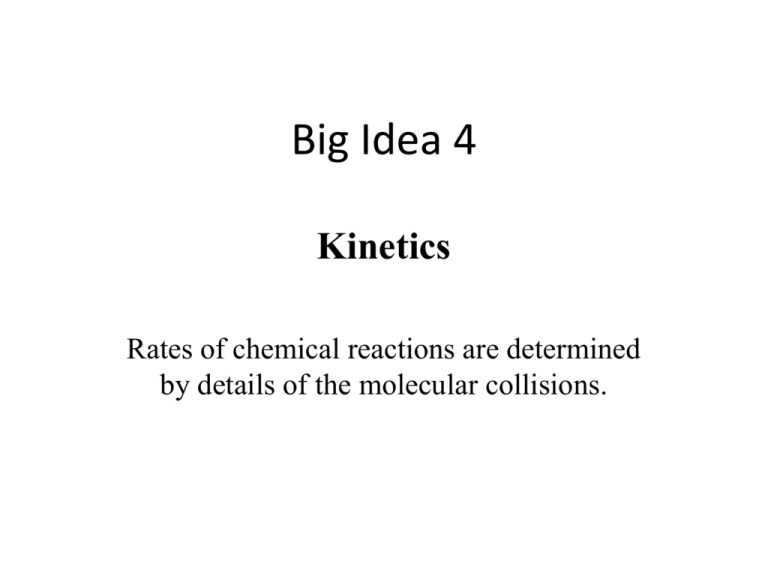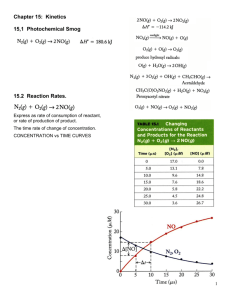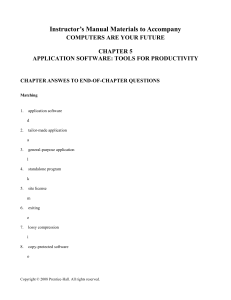Big Idea 4
advertisement

Big Idea 4 Kinetics Rates of chemical reactions are determined by details of the molecular collisions. Concepts covered: • • • • • • • • Factors that affect the rate of a reaction Stoichiometric relationships and rate of a reaction Determination of rate law equations Order of reaction – Rate law, integrated rate law, straight line graph, half life expression. Maxwell Boltzmann energy distribution Potential energy diagram Collision mechanisms Role of catalysts Factors That Affect Reaction Rates • Physical State of the Reactants – – In order to react, molecules must come in contact with each other. The more homogeneous the mixture of reactants, the faster the molecules can react • Temperature – At higher temperatures, reactant molecules have more kinetic energy, move faster, and collide more often and with greater energy. • Concentration of Reactants – Higher concentrations allow for more collisions. – The rate of the reaction decreases as reactants are consumed and their concentration decreases. • Presence of a Catalyst – – Catalysts speed up reactions by changing the mechanism of the reaction. Catalysts are not consumed during the course of the reaction. © 2009, Prentice-Hall, Inc. Reaction Rates C4H9Cl(aq) + H2O(l) C4H9OH(aq) + HCl(aq) • All reactions slow down over time. • Therefore, the best indicator of the rate of a reaction is the instantaneous rate near the beginning of the reaction. © 2009, Prentice-Hall, Inc. Reaction Rates and Stoichiometry • Reaction rates can be monitored by following either the loss (-) of reactants or the production (+) of products as generalized below: aA + bB Rate = − 1 [A] a t = − cC + dD 1 [B] 1 [C] 1 [D] b t = c t = d t © 2009, Prentice-Hall, Inc. Concentration and Rate NH4+(aq) + NO2−(aq) N2(g) + 2 H2O(l) We can gain information about the rate of a reaction by seeing how the rate changes with changes in concentration. If we compare Experiments 1 and 2, we see that when [NH4+] doubles, the initial rate doubles. © 2009, Prentice-Hall, Inc. Rate Laws Rate = k [NH4+] [NO2−] • The overall reaction order can be found by adding the exponents on the reactants in the rate law. • This reaction is second-order overall. © 2009, Prentice-Hall, Inc. Rate Law and Order or Reaction • • • • 0 order- the rate is independent of [reactant] 1st order- rate = [reactant] 2nd order- rate [reactant]2 3rd order- rate [reactant]3 Rate Law and Oder of Reaction • Since rate is defined as change in concentration (molarity)/time (s). The unit for k will vary based on the order of the reaction. 0 order: k = mole/L • s 1st order: k = 1/s 2nd order: k = L/mole • s 3rd order: k = L2/mole2 • s First-Order Processes • When ln P is plotted as a function of time, a straight line results. • Therefore, – The process is first-order. – k is the negative of the slope: 5.1 10-5 s−1. © 2009, Prentice-Hall, Inc. Second-Order Processes 1 [NO2] • Graphing ln vs. t, however, gives this plot. Time (s) [NO2], M 1/[NO2] 0.0 0.01000 100 50.0 0.00787 127 100.0 0.00649 154 200.0 0.00481 208 300.0 0.00380 263 • Because this is a straight line, the process is secondorder in [A]. © 2009, Prentice-Hall, Inc. Summary: Integrated rate law Order Rate Equation Integrated Rate Equation Straight Line Plot Slope k Units 0 Rate = k[R]0 [R]o - [R]t = kt [R]t vs. t -k mol/Ls 1 Rate = k[R]1 ln([R]o/[R]t) = kt ln[R]t vs. t -k s-1 2 Rate = k[R]2 (1/[R]t) - (1/[R]o) = kt 1/[R]t vs. t k L/mols memorize this! Half-Life and First-Order Reactions: (radioactivity is a first-order reaction) ln becomes ln(2) = kt½ ln(2) = 0.693 so… k = 0.693/ t½ and t½ = 0.693/k Reaction Coordinate Diagrams It is helpful to visualize energy changes throughout a process on a reaction coordinate diagram like this one for the rearrangement of methyl isonitrile. © 2009, Prentice-Hall, Inc. Catalysts • Catalysts increase the rate of a reaction by decreasing the activation energy of the reaction. • Catalysts change the mechanism by which the process occurs. © 2009, Prentice-Hall, Inc. Maxwell–Boltzmann Distributions • As the temperature increases, the curve flattens and broadens. • Thus at higher temperatures, a larger population of molecules has higher energy. © 2009, Prentice-Hall, Inc. Reaction Mechanisms The molecularity of a process tells how many molecules are involved in the process. © 2009, Prentice-Hall, Inc.








